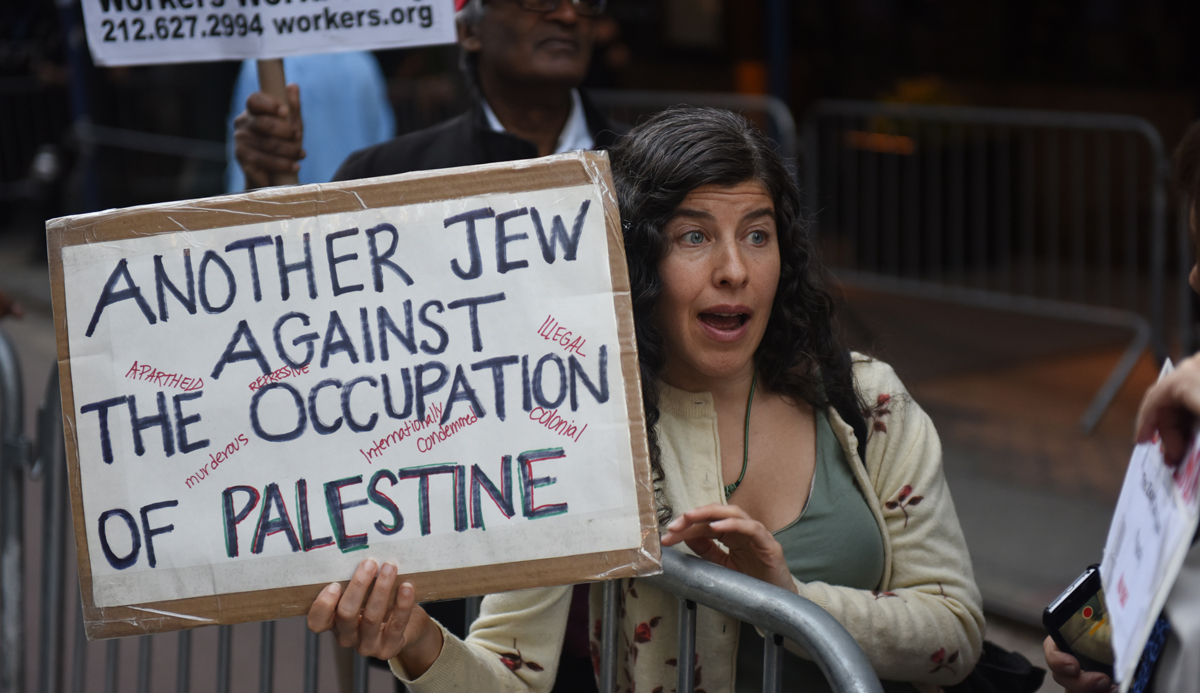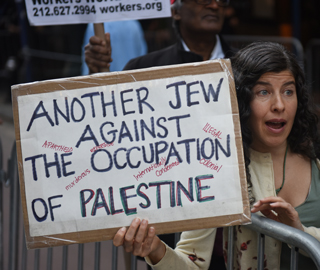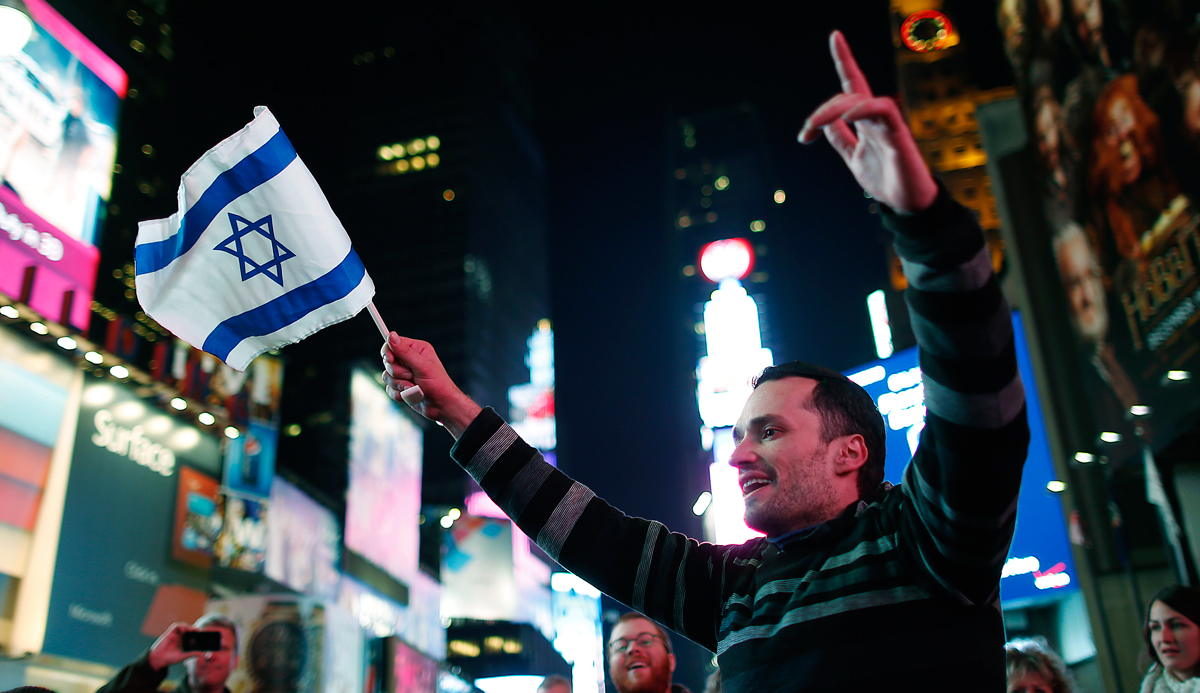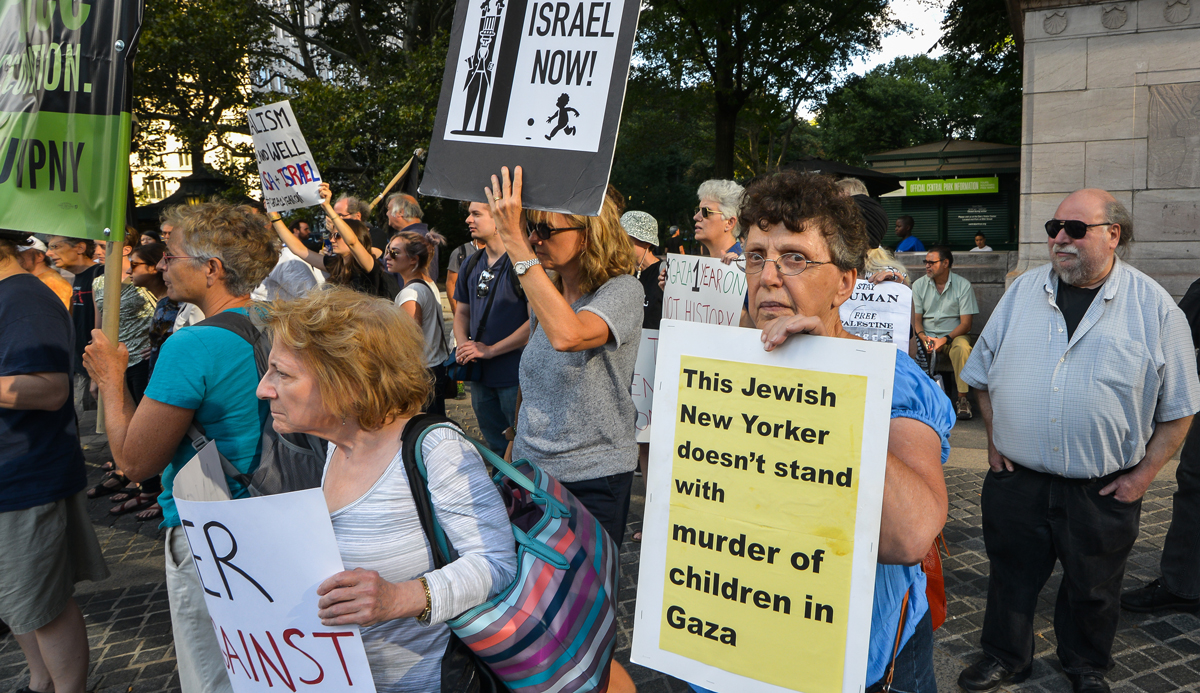Everyone knows that American Jews and Israel are drifting apart—and everyone is confident of the reasons why. Israel, it is said, has become increasingly nationalistic and right-wing; “the occupation” violates liberal values; and the American Jewish “establishment,” with its old familiar defense organizations and their old familiar apologetics, has lost touch with young American Jews who are put off by outdated Zionist slogans and hoary appeals for communal solidarity. In brief, the fundamental problem resides in the nature of the Israeli polity and the policies of the Israeli government, which together account for the growing misfit between Israelis and their American Jewish cousins.
This, at least, is the new conventional wisdom. It is wrong—but the precise ways in which it is wrong, and by means of which it mistakes and overlooks deeper realities, are worth examining.
Two new books by political scientists try to do just that: The Star and the Stripes: A History of the Foreign Policies of American Jews by Michael Barnett of George Washington University and Trouble in the Tribe: The American Jewish Conflict over Israel by Dov Waxman of Northeastern. The two books are being published almost simultaneously by Princeton University Press, presumably in the belief that the topic is not only intrinsically significant but should be of import and interest to experts and the wider public alike. And so it should.
Of the two books, Barnett’s offers the more careful analysis. But since Waxman’s more neatly captures the current wisdom—the author’s own views on Israel, as he is at pains to note, “evolved” from “uncritical support to a more critical engagement with the country”—it makes for a better starting point.
I. Goodbye Consensus, Hello Disillusionment
A British Jew who has lived in the United States for half his life, Dov Waxman in Trouble in the Tribe congratulates himself on having gained special insight into the American Jewish community and its psyche. But he also admits straight off that he is not exactly a detached observer. “My own politics surely come through at times,” he writes disarmingly—and about that he is entirely correct. Those politics will be familiar to anyone who has read (and believed) the writings of Peter Beinart.
The narrative goes like this: the “pro-Israel consensus that once united American Jews is eroding,” and “American Jewish conflict over Israel is replacing the old era of solidarity.” In fact, while “Israel used to bring American Jews together,” it is now “driving them apart.”
How so, and how new is this problem? To his credit, Waxman does note that the story he’s telling has historical antecedents. Reviewing (too briefly) the history of the American Jewish community’s relations with Israel, from the rise of the Zionist movement through Israel’s birth and its wars, he acknowledges that Zionism always presented a dilemma to American Jews, who did not consider themselves to be “in exile” from their homeland. In that respect, at least, the “old era of solidarity” to which he alludes was never quite so solid as he himself posits.
In any case, however, Trouble in the Tribe is mostly about today’s version of the story, when the “widespread sense of disillusionment” with the Jewish state is fueled, Waxman contends, not by ignorance but, to the contrary, by a growing enlightenment. The more American Jews know about Israel, he writes, the more disabused they become of what many now realize were naive misconceptions. As groups like J Street and Jewish Voice for Peace have arisen to press their critique of the Jewish state in the court of public opinion, the community is “being torn apart” by division. Of course, the establishment has tried hard to suppress dissent and crush these groups, but the “right-wing backlash” will not succeed.
Indeed, in Waxman’s view, the establishment’s anxiety is altogether misplaced. For the “distancing” from Israel that has been widely attested in surveys is in fact a hopeful sign, and may not even constitute distancing at all. Yes, some young, liberal American Jews, confronted with an Israel “becoming increasingly illiberal and increasingly isolated in the international community,” will “turn away from Israel in despair, or even disgust.” But many others will, like Waxman himself, move instead to “critical engagement.” These American Jews actually care very deeply about Israel, and wish only to save it from itself.
Israeli leaders, writes Waxman, should therefore expect “growing pressure from the American Jewish community to change Israel’s policies, especially toward Palestinians in the occupied territories.” As the project to save Israel from itself gathers steam, “it is hard to believe that any Israeli government, including the present one, [will be] completely immune to criticism, and that an increase in this criticism, by American Jews and others, will not eventually encourage, if not compel, Israeli policymakers to alter Israel’s present course.” In the end, it may be possible to persuade or compel these recalcitrant leaders, “foremost among them Prime Minister Netanyahu,” to “recommit Israel to the goal of establishing a Palestinian state as quickly as possible.”
II. Cosmopolitan Jews and Tribal Jews
As will already be evident, Trouble in the Tribe contains more in the way of ideology than careful engagement with empirical analysis. Do American Jews really have “greater knowledge” about Israel today than did their parents or grandparents? Why would that be, and where did they acquire their balanced and penetrating insights—by reading the New York Times? Is Israel really “increasingly illiberal”? Do American Jews truly think Israel is “increasingly isolated” in the world when they can read every week about its improved relations and growing trade with India and China, its growing security relations with the Arab states of the Middle East—not to mention its steadily high popularity among the majority of the American people?
Above all, is there any evidence whatsoever that, except as an empty slogan, “opposing, and even lobbying against, the policies of Israeli governments . . . has now become for many American Jews a way of supporting Israel” (emphasis added)? Waxman makes that claim repeatedly—but then repetition seems to be a key strategy in a book that restates its main theses several times in each chapter, making a poor substitute for demonstration.
Michael Barnett’s The Star and the Stripes is longer and its scope is wider: there is more history, covering not only the experience of Jews in America but what preceded it elsewhere in the Diaspora. In his analysis of the growing distance between American Jews and Israel—of which he is guardedly skeptical—Barnett focuses on the friction between two different perspectives within the community: on the one hand, the brand of “cosmopolitanism” and/or “prophetic Judaism” embraced by the non-Orthodox majority and, on the other hand, the more traditional and “tribal” approach that historically has placed the emphasis on protecting endangered Jews and securing and enhancing Jewish welfare.
This is by now an old story. With emancipation and the achievement of civil rights in Europe, Barnett writes, the old parochialism came up against both assimilationist and nationalist tendencies in the wider society. In the United States, the Reform movement reinterpreted the traditional idea of Jewish “chosenness” to be consistent with American pluralism. Jews were “chosen” not to dwell alone and apart but rather to be “working for the betterment of humanity.”
Zionism, from this perspective, long lay under a cloud of suspicion among American Jews, not only because it might raise dangerous charges of “dual loyalty” but also because, in focusing exclusively on the plight and future safety of Jews alone, it contradicted the ethos of liberal universalism. As Barnett reports, the American Jewish community and especially its leadership came late to the Zionist cause, which remained controversial among the German-Jewish elites who led most of the major organizations right up until and to a degree even after World War II. In fact, “Israel remained on the margins of American Judaism [well into] the 1950s and 1960s,” Barnett holds. During those decades, “despite the enormity of the world wars and the Holocaust,” American Jews were busy moving “from the cities to the suburbs, . . . living their dream. The other dream of a Jewish return to Palestine had never been their dream.”
But the reality had also begun to change. By the 1960s, the Holocaust was becoming “a defining symbol of and source of identity”; after the near-disaster and ultimate triumph of the June 1967 war, Israel too became “increasingly central to [American] Jewish identity.” Indeed, the two merged: “By the mid-1970s it became nearly impossible to think about Israel without also conjuring up the Holocaust, and vice-versa.” I would note here an additional development whose significance for communal solidarity and indeed for the Zionist spirit is underplayed by Barnett: namely, the movement on behalf of Soviet Jewry, which for a time in the 1970s and especially the 1980s brought together virtually all parts of the organized American Jewish community.
And yet not so fast. In terms of Barnett’s two perspectives, these concerns about exclusively Jewish problems and threats to Jewish communities abroad did not override, or sit comfortably with, the liberal and universalist impulses that remained powerful among American Jews. The American Jewish Committee (AJC) and other leading organizations had created a synthesis that was meant to substitute for Jewish parochialism. In this conception, the particular interests of Jews would be best protected not by tribalism, i.e., by focusing exclusively on fighting anti-Semitism and rescuing endangered Jews, but by creating a more just society, in which all forms of bigotry would be countered and destroyed, and by forging a world order built on peace, justice, and law. Thus, the AJC, in an internal memo quoted by Barnett, resolved “as a matter of enlightened self-interest, to interest ourselves in situations involving other minorities, even though Jews are not primarily affected.” During the 1960s, Barnett writes, the AJC’s American Jewish Year Book “often gave more prominence to the civil-rights movement than to Israel.”
This cosmopolitan outlook was itself consonant with the “prophetic Judaism” that had long been the hallmark of the Reform movement; today, it is increasingly the religion of all non-Orthodox American Jews. Tikkun olam, “repairing the world” through action for “social justice,” is regarded by many American Jews as more important than actually observing Jewish rituals or supporting Israel. It is also necessarily in tension, sometimes more and sometimes less, with the need and the desire to protect Jews who are in danger. When Israel or some other community of Jews seems at risk—as during the 1973 Yom Kippur war, for example, or when the Soviet regime was sending “refuseniks” to Siberia for the crime of seeking to learn Hebrew and move to Israel—the tribal instinct may appear to dominate, at least for a time. Still, that impulse is itself often framed in terms of universal themes like the concern for international human rights, the right to emigrate, the right to freedom of religion, and so forth.
Today, Barnett writes, when fewer Jews seem to be in physical danger, certainly in this country, and with Israel regarded as a major Middle Eastern power, many American Jews see no need whatsoever for the tribal approach. After all, “in 1914, 76 percent of all Jews lived in illiberal lands . . . [but] now a minuscule 3.5 percent live in authoritarian countries [while] 96.5 percent live in liberal democracies.” No wonder, then, that the “prophetic” or “cosmopolitan” outlook has prevailed, or that to some extent (again, Barnett is cautious about the “accepted wisdom”) American Jews are “losing their love for Israel.” He puts it this way: “there are forces at home and in the world that are leading American Jews to return to a political theology of prophetic Judaism, and an Israel that is increasingly acting like an ethnonational state is not the best outlet for such cosmopolitan longings.”
III. The Shrinking of the American Jewish Community
To sum up: both Dov Waxman in Trouble in the Tribe and Michael Barnett in The Star and the Stripes agree that criticism of Israel by American Jews is increasing, though they identify different reasons for the increase. For Waxman, the problem is mostly the rightward move of Israeli politics. For Barnett, the problem is the differing realities of Israeli and American Jews, a view he buttresses with a quotation from Steven M. Cohen and the late Charles Liebman:
Each group has in effect chosen to attribute Judaic values to its own environment. For Israelis this means Jewish people, land, and state; for American Jews it perforce includes not just Jews but the larger society of non-Jews as well.
At the very end of his book, Barnett wonders what sorts of threat to Jewish security it would take before the American Jewish perception of reality would change. Here’s his list of potential threats: “a Europe that abandoned its Jews to the new anti-Semitism, an Israel that became surrounded by radical Islamic forces that were actively attempting to destroy it, or an Israel that made the Arabs second-class citizens or attempted to cleanse the territories of non-Jews.”
Even setting aside the discordant and seemingly gratuitous final item, this list would surely strike many Israelis, and even many Diaspora Jews, as odd if not positively bizarre in its speculative forecasting of what are already present-day realities. A world presenting fewer and fewer physical threats to Jews? To Israel’s north in Syria sits Islamic State (IS), a brutal and murderous Islamist terrorist group of growing global vitality. To the east, Jordan is now burdened by roughly 1.3 million Syrian refugees, the eventual economic and political impact of whose presence cannot be measured. And somewhat farther east sits Iran, busily building its ballistic-missile program in service of the clear path to a nuclear bomb allowed by last November’s six-power agreement, while also mobilizing Hizballah and its own Revolutionary Guard (IRGC) troops just miles from Israel in Syria. To the south lies Sinai, riddled now with IS and other terrorist groups that despite efforts by the regime in Cairo are growing in size. Each week, and almost each day, brings another Palestinian terrorist attack, in a series that has reached over 200 stabbings, over 80 shootings, over 40 vehicular attacks, with dozens killed and hundreds wounded. And has not Europe, where in city after city Jews are warned not to walk in the street displaying any sign of their religion, “abandoned its Jews to the new anti-Semitism”?
Barnett postulates that any such development might change the perceptions of American Jews. That has decidedly not been the case: neither the rise of IS, nor the new “stabbing intifada” that Israelis now face, nor the dire threat of anti-Semitism in the heart of liberal and democratic Europe—nor, for that matter, the swelling tide of anti-Semitism on American university campuses, to which so many American Jewish parents entrust their own children—none of this has appeared to have much if any impact on the way most American Jews see and judge Israel in particular or the Jewish situation in general.
Nor is it likely to. For the real problem with the analyses of both Waxman and Barnett is their focus on external phenomena—mainly Israel and Israeli government policy—as the source of the developments under inspection. Neither sufficiently considers the alternative: that the explanation for the criticism or distancing resides not in Israeli conduct, which is actually a minor factor, but instead almost entirely in the changing nature of the American Jewish community itself.
Consider this question: how does the relationship between Israel and the Australian, Canadian, or British Jewish community differ from that of Israel and the American Jewish community? If one seeks an answer that can be quantified, note that, even taking into account the effect of the Birthright program—which to date has sent 400,000 young American Jews on trips to Israel—it is still the case that only about 40 percent of American Jews have bothered to visit the country at all. Without Birthright, that proportion would shrink to a third. By contrast, approximately 70 percent of Canadian Jews have made the trip at least once, as have 80 percent of Australian Jews and an estimated 95 percent of British Jews. Beyond the Anglosphere, 70 percent of French Jews have visited Israel, as have 70 percent of Mexican Jews and more than half of Argentinian Jews.
In many ways the British, Australian, and Canadian Jewish communities, though much smaller than that of the United States, are internally stronger than the American Jewish community, and more Zionist as well. They also tend to cast their votes for the political party that supports Israel, having switched allegiance in recent decades to help elect Australia’s Liberal party as well as leaders like Margaret Thatcher in the UK and Stephen Harper in Canada. By comparison, very little political mobility is visible in the United States, where in 2012 an estimated 70 percent of American Jews voted to re-elect President Barack Obama despite the tensions between his Democratic administration and Israel, just as 76 percent had voted against re-electing a Republican president, George W. Bush, in 2004 despite the excellent relations between Washington and Jerusalem at the time.
Why do American Jews appear to care less about Israel and feel less solidarity with it than do Jews living elsewhere in the Anglosphere? It is sometimes argued that, because both political parties in the United States express strong support for Israel, voting patterns measure nothing. That is hard to square with the fact that the state of actual relations between the two countries, which rises and falls considerably, hardly affects the voting pattern at all.
A partial exception to these electoral habits is to be found in the Orthodox community. And here we begin to approach what may be the more persuasive explanation for the growing distance between American Jews and Israel and/or the growing criticism of the Jewish state. Just who are the American Jews? Surprisingly enough, Waxman’s book, despite its strong ideological slant, supplies the answer.
Listing the various ways one can analyze attitudes toward or levels of support for Israel in the American Jewish community, Waxman begins with the “denominational divide”—that is, Orthodox versus non-Orthodox—before discussing the “ideological and partisan divide.” As he correctly writes, religiously conservative Jews “tend to be more emotionally attached to Israel” than religiously liberal Jews. When it comes to politics, moreover, the “partisan” division makes sense: “Simply put, while Democrats have gradually become more critical of Israel, Republicans have become much more supportive.”
Waxman then turns to the “generational divide,” stating that “young American Jews are far more critical of [Israel] than their parents or grandparents. . . . Even more strikingly, young Jews are also more critical of U.S. government support for Israel,” and “young, non-Orthodox American Jews are less suspicious of the Palestinians.” Putting things together, we get this: many “well-educated, liberal, young American Jews . . . have flocked to join groups on college campuses like J Street U, Open Hillel, and, further to the left, Jewish Voice for Peace,” the last of which is a radical anti-Zionist, pro-BDS faction.
And then, really putting things together, we get to the crux of the matter:
Perhaps the biggest reason why young American Jews tend to be more dovish and more critical of Israel is because they are much more likely than older Jews to be the offspring of intermarried couples. Intermarriage undoubtedly has an impact upon the political attitudes and opinions of the children of such unions. Young American Jews whose parents are intermarried are not only more liberal than other Jews, but also significantly less attached to Israel. As such, it is hardly surprising that this rapidly growing subgroup within the American Jewish population has very different views about the Israeli-Palestinian conflict than other American Jews.
This should not be surprising. As Lawrence Hoffman, a scholar at Hebrew Union College and himself a prominent Reform rabbi has written: “[T]he disappearance of the sort of ethnic solidarity that prior generations enjoyed as a matter of course . . . [and] our high intermarriage rate . . . means that Jews of the next generation will increasingly be people with no childhood Jewish memories and no obvious reason to maintain Jewish friends, associations, and causes at the expense of non-Jewish ones.”
Among those “causes” will be Israel. Why should that be? Surely the points made by Hoffman suggest the answer, and the massive 2013 Pew survey of the American Jewish community confirms it. One big part of that answer, perhaps the biggest, is the intermarriage rate, now higher than 50 percent of all American Jews who have married since the year 2000—nearly six in ten, according to Pew. (Intermarriage rates among Orthodox Jews are negligible, estimated by Pew at 2 percent.) Moreover, within the group of Pew respondents who are themselves the married children of intermarriage, the intermarrying figure of nearly six-in-ten rises to over eight-in-ten.
Thus, Pew found that persons of “Jewish background”—mainly, those with only one Jewish parent—express significantly lower levels of support for Israel than do “Jews by religion.” Of the former, fully 41 percent report being “not too” or “not at all” emotionally attached to Israel, and only 13 percent have ever traveled there.
Similar findings relate to the sense of Jewish peoplehood. According to the Pew study, only 20 percent of Jews with a non-Jewish spouse say they are raising their children exclusively as Jews. When asked if they have a strong sense of belonging to the Jewish people, only 59 percent say yes—as against 92 percent of those married to Jews—and only 49 percent say they feel a special responsibility to care for Jews in need—as against 80 percent of those married to Jews.
Intermarriage is of course not the only way to distinguish levels of communal solidarity; religion itself is another. Half of those who identify themselves as Jews by religion say that “caring about Israel” is “essential” to what it means to them to be Jewish, while only 23 percent of those identifying themselves as non-practitioners believe that to be so in their case. And age is another factor: Jews sixty-five and older are far more likely to say caring about Israel is essential than those who are under thirty.
It is the latter phenomenon that has produced the conclusion that younger American Jews are distancing themselves from Israel. There are obviously data to support that conclusion, but they are meaningless unless we understand what lies behind them. Waxman thinks it is because the young are offended by “the occupation” and the policies of a Likud government, and Barnett does not differ very much from that conclusion. A deeper analysis suggests that we are dealing here with a far broader phenomenon, and one in which sheer indifference may count as much as or more than critical disagreement with Israeli policies or an active desire to disembarrass oneself of association with an “ethnonational state.”
The erosion of ethnic solidarity among American Jews is in part a product, no doubt, of the unique openness of American society, the weakness of anti-Semitism, and the assimilation of Jews here—a much more rapid and more thorough process than has been the case elsewhere in Diaspora history. Just as Irish, Italian, and Polish Americans have lost most of their distinctive ethnic characteristics and are now more simply American Catholics, in the U.S. the sense of Jewish peoplehood as the core of “Jewishness” has largely been replaced by Judaism as a religion—if one that most American Jews do not actively practice.
And that is a problem: to cite Hoffman again, “the [mere] ethnicity of people without profound purpose is doomed.” In his judgment, and in the absence of an automatic identification with Israel, that profound purpose can be supplied only by “regularized ritual affirmations of the transcendent religious purpose justifying and demanding” religious commitments: in other words, precisely the sort of religious observance that the vast majority of American Jews avoid or eschew.
Indeed, as we have seen, not only does a growing portion of the American Jewish community not practice the religion at all, but a majority marry non-Jews, and so do an even larger majority of the children of intermarried couples. Every official and fundraiser for Jewish philanthropies or the communal federations knows this, and knows the effect it has wrought on the communal ties that historically led to concern about the fate of other Jews, including in the land of Israel.
IV. The Problem Is Here
What is to be done? Reversing the major demographic trends in the American Jewish population, for example by increasing endogamous marriage, does not seem to be in the cards. Where the Jewish state is concerned, should Israel and its American supporters rely more heavily on the Orthodox, whose sense of community and of closeness to Israel is intact? Turn outward and work more closely with evangelical Christians? Reach out to growing population groups like Hispanics and Asians? Seek to strengthen hasbarah programs whose goal is to increase support for Israel among the American public in general?
Each of these suggestions has its value, and its limitations. But the beginning of wisdom is surely to understand that the problem is here, in the United States. The American Jewish community is more distant from Israel than in past generations because it is changing, is in significant ways growing weaker, and is less inclined and indeed less able to feel and express solidarity with other Jews here and abroad.
The government of Israel and the Jewish Agency are right to be thinking about how the Jewish state can help, over the coming generations, to strengthen the community, for Israel’s sake and for ours. What should be dismissed are the unhelpful efforts to politicize these developments and transform them into weapons against Israel’s government. Are we really to believe that someone who chooses not to engage with any part of the organized Jewish community, who does not belong to a synagogue and considers himself (in the Pew study’s terminology) a “Jew of no religion,” who has never visited Israel, who has married a non-Jew who did not convert and whose children are not being raised as Jews, feels less attached to Israel than his parents or grandparents because of settlements or “the occupation”? Or that such a person would become a strong supporter of and frequent visitor to Israel if only the Labor or Meretz party were to win an election?
Defending Israel and Israeli policies can be a task undertaken with gusto and commitment by American Jews. So can defending Israel while seeking to change or moderate certain policies or realities (like settlement policy, or the treatment of non-Orthodox Judaism); such is the practice in Israel itself of the Conservative and Reform movements, neither of which, despite the discriminatory treatment they receive there, has been led (in Waxman’s words) to “turn away from Israel in despair, or even disgust.” All too often, however, the default position of American Jews has been to see the defense of the Jewish state as a terrible burden that the ungrateful Israelis have placed on us and obstinately refused to lift.
I encountered one such Jew last fall at the annual session of the Brookings Institution’s Saban Forum, a conference attended by Israeli and American officials and former officials together with charitable donors, policy analysts, and journalists, the great majority of whom are Jews. During my own panel session, one audience member rose to speak with anguish about his daughter’s ordeal at her college. There was so much criticism of Israel, he lamented; the critics were harsh, and tough, and smart; the defenders had a very rough time; it was all so unpleasant. Surely, he adjured us, Israel needs to be aware of this and to change the policies that are imposing this painful experience on young American Jews.
Here was an echo of Waxman’s advice to increase the pressure on Israeli policymakers in a manner that will “eventually encourage, if not compel [them] to alter Israel’s present course.” Our unhappy parent did not pause to ask why and wherefore the college had chosen to play host to so bitter and hostile an atmosphere, or to wonder about the possible complicity of deans or professors in the affair and the relevant responsibilities of administrators. Nor did he question whether perhaps he had failed as a parent to help choose the right campus for his daughter, or reflect on his child’s or her fellow Jewish students’ lack of preparedness for these increasingly frequent scenes, or inquire as to why anti-Israel voices were so much better armed. Nor, finally, did he appear to think twice about the appropriateness of judging policies meant to protect literally embattled Israelis by the standard of how they might disturb the comfort of politically or socially embattled American students.
Perhaps the Israeli and American Jewish communities will drift farther apart, and perhaps the level of criticism will rise. Work should be done, by all means, to prevent or minimize such trends. But the problems with which we are dealing won’t be solved by casting blame on Israelis or their politics. The problems begin at home, and so do the solutions.
More about: American Jewry, American-Israeli Affairs, Israel & Zionism, new-registrations








